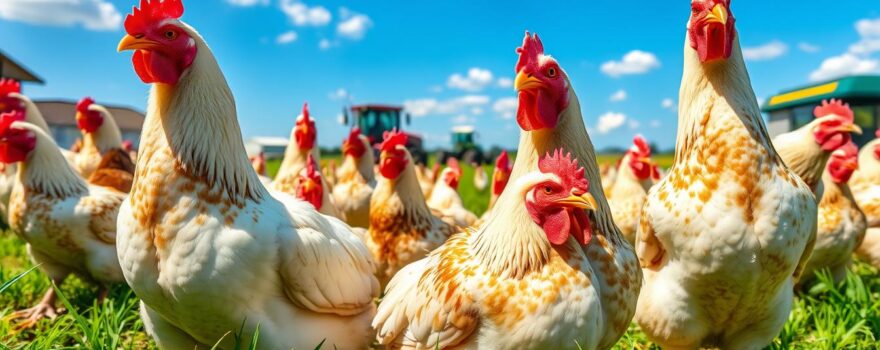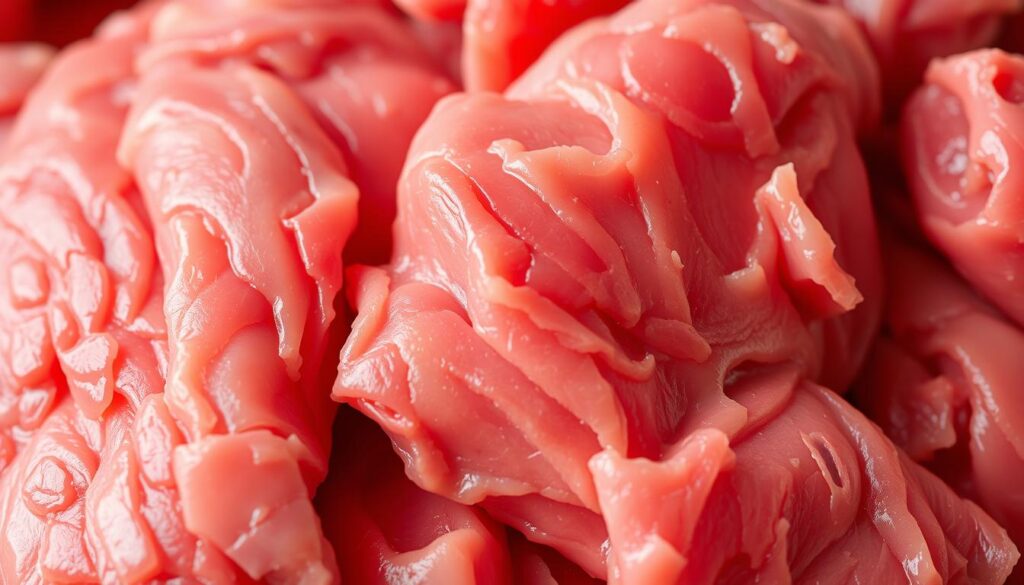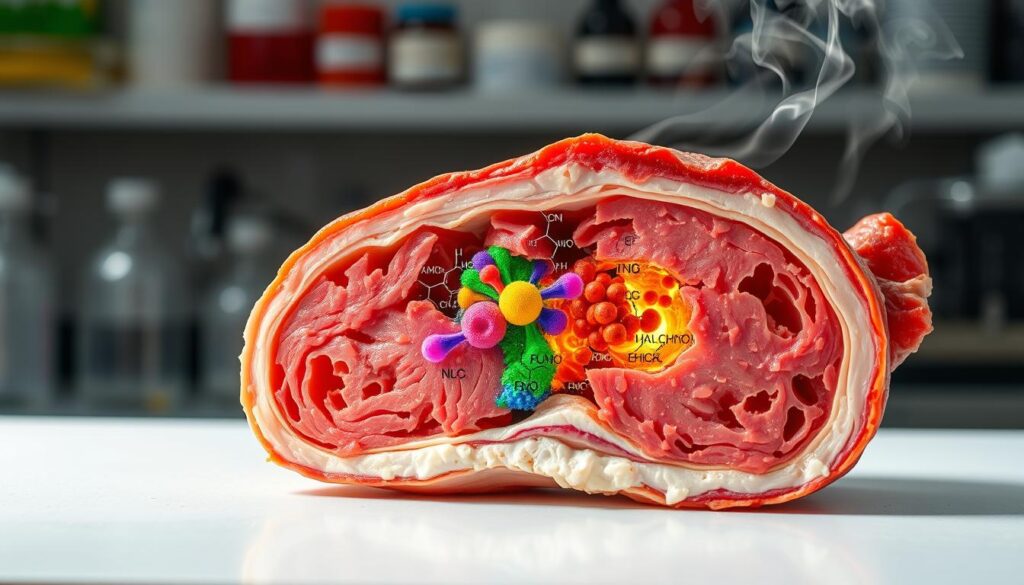
The global production of broiler chickens has grown a lot in recent years, as shown by FAOSTAT 2021. This shows how key it is to meet consumer demands for top-notch poultry meat. People today care a lot about the quality and how food is made, including animal welfare, sustainability, and nutrition. It’s vital for the poultry industry to offer broiler chicken products that match what consumers want to keep and grow its market share.
The material discusses the importance of meeting consumer expectations for broiler chicken in terms of appearance, texture, juiciness, and flavor. The quality of broiler meat is influenced by its appearance and texture, like color and how well it holds water and tenderness. Consumer wants, genetics, nutrition, management, processing, and breeding all matter a lot in making sure broiler chicken quality meets what consumers and the industry expect.
Key Takeaways
- Broiler chicken production has significantly increased, highlighting the need to meet consumer demands for high-quality poultry meat.
- Consumers are increasingly concerned about the quality and production methods of their food, including animal welfare, sustainability, and nutritional value.
- Providing broiler chicken products that align with consumer preferences is crucial for the poultry industry to maintain and grow its market share.
- Factors such as appearance, texture, juiciness, and flavor are important in determining broiler meat quality.
- Consumer expectations, genetics, nutrition, management, processing, and breeding all play a role in ensuring broiler chicken quality meets industry standards and consumer preferences.
Introduction to Broiler Chicken Meat Quality
Poultry meat quality is more than just looks and taste. It also includes how nutritious the meat is. From the consumer’s view, quality means the meat meets their expectations when cooked and eaten. The quality of broiler chicken meat depends on many things, like the bird’s genetics and how it’s raised.
Definition of Poultry Meat Quality
Poultry meat quality is about how much people like and want the meat. It’s about how it looks, feels, tastes, and smells. All these things make the meat good or bad in the eyes of the consumer.
Factors Influencing Poultry Meat Quality
- Genetics: The bird’s genetics can affect its meat quality.
- Feeding program: What the bird eats can change the meat’s taste and nutrition.
- Housing conditions: The bird’s living space can impact its health and meat quality.
- Pre-slaughter handling: How birds are treated before being killed can affect the meat.
- Processing techniques: Methods like stunning and deboning can also impact the meat’s quality.
- Environmental conditions: The meat’s quality can be affected by how it’s stored and transported.
Knowing and managing these factors is key for the poultry industry. It helps them make sure their chicken is of high quality and meets what customers want.
Consumer Concerns and Preferences for Broiler Chicken Welfare
People in the US and worldwide are more concerned about animal welfare, including broiler chickens. Surveys show most consumers think it’s key to protect farm animals. Many are also ready to spend extra for products from systems that care for animals better.
Importance of Animal Welfare for Consumers
In the US, 78% of people worry about how chickens are raised. In China, two-thirds support laws to improve chicken living conditions. The EU’s 94% believe in protecting farmed animal welfare, and 82% think it should be better now.
Preferences for Higher Welfare Production Systems
Many consumers prefer chicken from better systems over conventional ones. They’re willing to pay more for chicken from systems with more space and enrichment. In Denmark, France, the Netherlands, and the UK, people are ready to pay 5% to 30% more.
In the US, consumers would pay 48% more for chicken with a welfare certification. This shows a clear preference for higher welfare chicken.
In Kenya, urban consumers are willing to pay 72% more for chicken with welfare labels. In Brazil, informing consumers about animal welfare on chicken packaging is seen as important.
The growing concern for animal welfare and the willingness to pay more for better products are key. They show the need for the broiler chicken industry to address these issues.
Appearance and Color of Broiler Chicken Meat
The color of raw and cooked poultry meat is very important to consumers. They see it as a sign of freshness and quality. Many things can change the color of poultry meat, like the bird’s age, diet, and how it’s processed.
Factors Affecting Meat Color
More than 92 million tons of poultry meat are produced worldwide. Fast-growing broiler hybrids reach market weight in just 40 days. Their breast meat has more moisture than slow-growing birds.
Organic rearing makes chicken meat yellower. But, meat from fast-growing birds looks redder and less yellow than slow-growing ones.
Discoloration and Bruising
Discoloration can happen in whole muscles or just in certain spots, like bruises. Extreme temperatures, stress from handling, and processing injuries can cause discoloration in broiler and turkey meat. About 29% of all carcasses in the U.S. are downgraded because of bruising.
The look of bruises can change over time. They can start as a fresh, red color and turn to normal flesh color. The amount of ‘blood’ and clotting can tell when the injury happened.

“Poultry meat discoloration can result from factors like bird age, sex, strain, diet, intramuscular fat, and processing variables.”
How to Meet Consumer Expectations for Broiler Chicken Meat Quality
To meet the growing demand for high-quality broiler chicken, the industry must improve several key areas. These include appearance, texture, and flavor. Strategies that also focus on animal welfare and sustainability are also important.
Optimizing pre-slaughter conditions is a key strategy. This means reducing stress and ensuring proper bird handling. Better processing techniques, like stunning and deboning, also improve meat quality. Using higher-welfare production systems that care for chickens’ well-being is another way to meet expectations.
Clear labeling and transparency are crucial. Giving accurate information about production methods helps build trust. This way, the industry can support consumer choices that reflect their values.
“Over 130 food companies have signed on to the Better Chicken Commitment to improve the welfare of broiler chickens in their supply chain by 2024.”
The poultry industry must keep evolving to meet changing market demands. Embracing innovative strategies to enhance broiler chicken quality is key. This will help the industry stay competitive and sustainable.
Texture and Tenderness of Broiler Chicken Meat
The texture and tenderness of chicken meat are key to making customers happy. How soft the meat is depends on the changes it goes through after the chicken dies. Things like stress before death, the environment, and how it’s processed can make the meat tough.
Rigor Mortis and Meat Tenderness
To solve this problem, the industry has tried using electrical stimulation after the chicken dies. This method helps the meat become tender faster. It also makes the process more efficient, saving time and money.
Deboning Time and Electrical Stimulation
When chicken is deboned can affect how tender it is. If done too soon, the meat can be tough. To fix this, the meat is usually aged for a few hours before deboning. But this can be expensive.
Using electrical stimulation after death is a new solution. It makes the meat tender and allows for deboning sooner, within 2 hours.
| Attribute | Normal Fillets | Severe Woody Breast Fillets |
|---|---|---|
| Overall Impression | Higher | Lower |
| Chicken Texture Scores | Higher | Lower |
| Compression Force | Lower | Greater |
| Sarcomere Length | Shorter | Longer |
| Cook Loss | Lower | Greater |
The study found that Woody Breast affects how people describe and like chicken. The quality of the meat also depends on Woody Breast and the chicken’s age.
Flavor of Broiler Chicken Meat
Flavor is a key quality that people look for in chicken. It comes from taste and smell, shaped by cooking processes. These include sugar-amino acid interactions, lipid and thermal oxidation, and thiamin degradation. While some factors like the chicken’s age and diet can affect taste, it’s hard to make a big difference in flavor through production alone.
The special lipids and fats in chicken are what give it its unique taste. These lipids and their chemical processes during cooking are key to the flavor we all love.
Chemical Processes Contributing to Flavor
Several chemical processes are important for the flavor of broiler chicken:
- Sugar-amino acid interactions: These Maillard reactions create savory, umami-like compounds that add to the flavor.
- Lipid and thermal oxidation: The breakdown of poultry fats and lipids during cooking makes volatile compounds that give off aromas and flavors.
- Thiamin degradation: The breakdown of thiamin (vitamin B1) leads to the formation of sulfur-containing compounds, which add meaty, savory notes to the flavor.
Understanding and managing these chemical processes during poultry cooking is key to ensuring the flavor that consumers want from broiler chicken meat.

“Flavor is the foundation of poultry meat quality and a key driver of consumer satisfaction. Optimizing the chemical reactions that contribute to broiler chicken flavor is essential for meeting market demands.”
Labeling and Transparency for Broiler Chicken Products
Clear labeling is key for consumers to make smart choices. It helps the industry improve animal care and sustainability. Without clear labels, 85% of US shoppers find it hard to trust what they buy.
Importance of Clear Labeling
People everywhere want to know how meat is made. In the UK, most adults link ‘free range’ and ‘organic’ with better animal care. In Belgium, over 90% of people like ‘free range’ chicken breast claims.
Consumer Support for Production Method Labeling
Knowing about organic farming boosts organic chicken’s appeal. Shoppers are ready to pay more for products with good welfare labels. They’re willing to spend up to 48% more for certified chicken.
Moreover, 70% of people check labels for animal care. And 57% might choose a restaurant for its animal welfare products, even if it costs more.
| Statistic | Value |
|---|---|
| Consumers who consider transparency in animal protein “extremely” or “very” important | Two-thirds |
| Consumers who consider at least one of the four areas (health, animal welfare, plant, or social responsibility) when buying meat and poultry | 85% |
| Certified animal products (e.g., Certified Humane, Global Animal Partnership, Animal Welfare Approved) in the US | Approximately 5% of animals raised for animal source foods |
It’s clear that shoppers want to know more about their chicken. They’re willing to spend extra for products that show they care about animal welfare and the planet.
Impact of Breeding and Genetics
More people are thinking about animal welfare and the ethics of food production. This has made the impact of breeding on broiler chicken quality a big worry. Surveys show most US consumers care about how chickens are raised, including breeding and genetics.
People want to know if chickens are prone to disease because of breeding. They also value chickens being able to eat easily, which can be affected by fast growth genetics. The industry needs to address these concerns to meet new standards for quality and ethics in poultry.
Consumer Attitudes Towards Breeding Practices
A recent survey found 78% of US consumers worry about chicken raising methods. This includes breeding practices and genetic selection. It shows more people are aware of the health and welfare issues linked to intensive breeding.
| Trait | Genetic Line A | Genetic Line B | Genetic Line C |
|---|---|---|---|
| Color (L*) | 55.8 | 56.4 | 54.6 |
| Color (a*) | 2.8 | 2.5 | 3.3 |
| pHinitial | 6.2 | 6.0 | 6.3 |
| Drip Loss (%) | 2.1 | 2.6 | 1.8 |
| Cooking Loss (%) | 19.8 | 21.2 | 18.9 |
This table shows how breeding practices and genetic selection affect meat quality. The big differences between genetic lines highlight the need to address consumer worries about animal welfare and health.
“Addressing consumer concerns about the impacts of breeding on broiler chicken welfare and health is an important consideration for the industry as it aims to meet evolving consumer expectations for high-quality and ethically-produced poultry products.”
Conclusion
The global broiler chicken industry must meet high-quality meat standards. This is crucial for meeting consumer demands for animal welfare, sustainability, and transparency. By focusing on appearance, texture, and flavor, and using better production methods, the industry can meet these needs.
Research and innovation are key for the industry to keep up with market trends. Collaboration between producers, processors, and consumers is essential. This ensures that broiler chicken products remain trustworthy and appealing to consumers.
Studies show that consumers accept broiler breast meat with varying degrees of white striping up to 91% (Kuttappan et al., 2012). The quality of breast meat can also improve up to 96% with better EU electrical stunning conditions (Sirri et al., 2017). This shows the industry’s potential to enhance meat quality and meet consumer preferences.
Research on market orientation in food and agriculture (Grunert et al., 1996) and older consumers’ meat consumption in the EU (Grunert et al., 2021) offers valuable insights. By using these insights and the latest advancements in genetic selection, the industry can deliver broiler chicken products that exceed customer expectations. This will help maintain consumer trust in the long term.